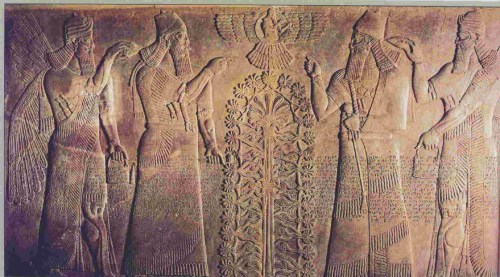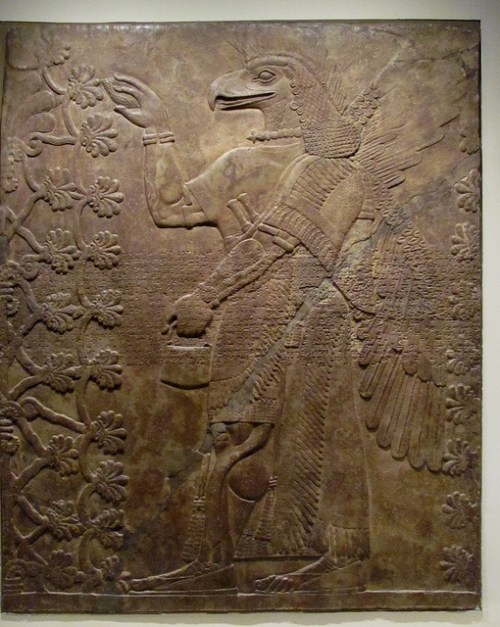The Tree of Life = The Tree of Knowledge
“But the cedar was something more than a world-tree. It was employed, as we have seen, in incantations and magic rites which were intended to restore strength and life to the human frame. It was thus essentially “a tree of life,” and the prototype and original of those conventional trees of Iife with which the walls of the Assyrian paiaces were adorned.

Stone relief from the throne room of Ashurnasirpal II.
Nimrud (ancient Kalhu), northern Iraq. Neo-Assyrian, 870–860 BC.
This Assyrian relief is from the throne room of the North-West Palace of Ashurnasirpal II (reigned 883-859 BC) at Nimrud in northern Iraq. It was originally positioned behind the king’s throne.
Ashurnasirpal appears twice, shown from two sides, dressed in ritual robes and holding a mace symbolising his authority. The figure of the king on the right makes a gesture of worship to a god in a winged disk in the top centre of the relief.
The source of the king’s power may be Ashur, the national god, or Shamash, the god of the sun and justice.
He holds a ring in one hand, an ancient Mesopotamian symbol of god-given kingship. The figure of the king on the left appears to gesture towards a Sacred Tree in the centre. This balanced combination of steams and foliage is a symbol of fertility and abundance given by the gods.
Behind the king, on either side of the relief, is a winged protective spirit who blesses and purifies Ashurnasirpal using a cone-shaped object to sprinkle liquid from a ritual bucket. The relief thus summarises visually the main ideas of Assyrian kingship; he is the source of abundance provided by the gods.
Ancient visitors approaching the enthroned king would have thus seen three royal figures, the living king facing them, and, on either side of him, two carved images showing Ashurnasirpal’s relationship with the gods.
Emerging from behind the king himself would be the Sacred-Tree.
There was another almost identical relief opposite the main door of the throne room, and similar scenes occupied prominent positions in other Assyrian palaces. They were also embroidered on the royal clothes.
J.E. Reade, Assyrian sculpture (London, The British Museum Press, 1983)
Excavated by Austen Henry Layard, 1845-7
ME 124531, Room 7-8: Assyria: Nimrud
http://www.britishmuseum.org/explore/highlights/highlight_objects/me/s/stone_throne_room_relief.aspx
Those who have visited the Assyrian collection of the British Museum will remember the curious form which it generally assumes, as well as the figures of the two cherubs which kneel or stand before it on either side. At times they are purely human; at other times they have the head of a hawk and hold a cone–the fruit of the cedar–over the tree by whose side they stand.

Alabaster relief from Nimroud, in the Louvre. The cone, or “fruit of the cedar,” is in the right hand of the eagle figure.
http://world-mysteries.com/mpl.htm
It is possible that, as time went on, another tree became confounded with the original tree of life. The palm was from the earliest period characteristic of Babylonia; and while its fruit seemed to be the stay and support of life, the wine made from it made “glad the heart of man.”
Date-wine was largely used, not only in Babylonian medicine, but in the religious and magical ceremonies of Babylonia as well. It is not at all improbable, therefore, that the later Babylonian tree of life, with its strange conventional form, was an amalgamation of two actual trees, the cedar and the palm.

Donald A. MacKenzie, Myths of Babylonia and Assyria, 1915, p. 340.
http://www.sacred-texts.com/ane/mba/img/34000.jpg
It is even possible that while one of them, the cedar, was primarily the sacred tree of Eridu, the other was originally the sacred tree of some other locality of Chaldea.
What gives some colour to this last suggestion is, that in later Babylonian belief the tree of life and the tree of knowledge were one and the same.
The text which describes the initiation of a soothsayer associates the cedar with “the treasures of Anu, Bel and Ea, the tablets of the gods, the delivering of the oracle of heaven and earth.” It was upon the heart or core of the cedar, too, that the name of Ea, the god of wisdom, was inscribed.
And it was wisdom rather than life, the knowledge of the secrets of heaven and the magical arts that benefit or injure, which the priesthood of Babylonia and the gods they worshipped kept jealously guarded.
Only the initiated were allowed to taste of its fruit. In this respect, consequently, there was a marked difference between the belief of the Babylonians and the account which we find in the earlier chapters of Genesis.”
A.H. Sayce, Lectures on the Origin and Growth of Religion as Illustrated by the Religion of the Ancient Babylonians, 5th ed., London, 1898, pp. 241-2.
